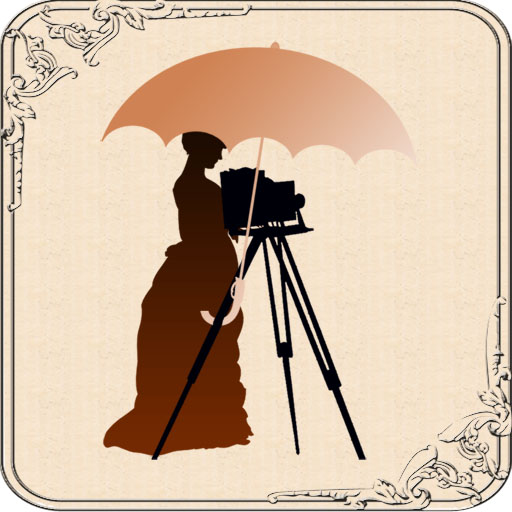Notes
Several different things to follow up with today for the connections to each of the women I mentioned.
Cornelia Baxter and Mrs. B.B. Chase:
Here’s the photo I mention of Cornelia Baxter Tevis McKee and her children. Note: this photo was from the newspaper; it was NOT taken by Mrs. B.B. Chase, and of course is not the photo that was taken before Cornelia’s wedding that was stolen from Mrs. Chase’s studio. (I’d love to find that one!) In any case, here’s Cornelia in the throws of of her messy divorce/custody battle circa 1915:

For more information about Mrs. B.B. Chase and her photography, refer to Episode 22.
Julia Skolas
There’s been some research done on Julia Skolas, including an essay published in a book available from the Pikes Peak Library District Special Collections department. They have also digitized a lot of her work, and that’s available in their digital collectons online at this link. They have a nice assortment of examples of her work; click on a link in the list below to view an example of that category in the Pikes Peak Digital Collections :
- portrait,
- photos inside the mine
- hand-tinted vistas
- photos of Julia herself, including one of her with her cat
Julia Bottomley
As far as I can tell, Julia Bottomley did artisan studio photography when she worked with her husband, T.F. Bottomley, in the late 1880s (in Kentucky) and 1890s (in Colorado). By I haven’t tracked down any photographic works that are definitely either by her, or produced from the T.F. Bottomley studio when she worked there with him. However, by 1900 she has becomes a very success syndicated fashion writer. Here’s a look at a 1915 headline/photo/byline for one of her articles:
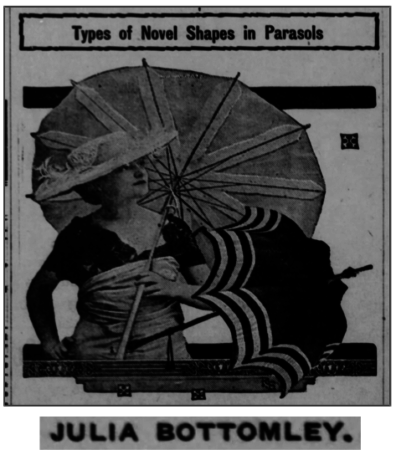
And here’s her 1924 passport photo that I mention in the episode:
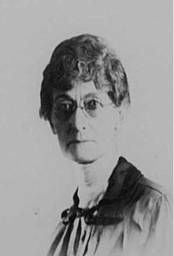
Lucinda Converse Dougherty Clark Mosley (Mrs. R.A. Clark)
Here’s the announcement in the newspaper when Mrs. Clark opens her studio:

Unfortunately, I haven’t yet run across any examples of Mrs. R.A. Clark’s photographic output from her studio.
However, I have run across photos of Lucinda and 2 of her 3 husbands.
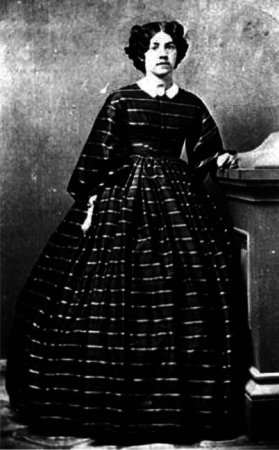
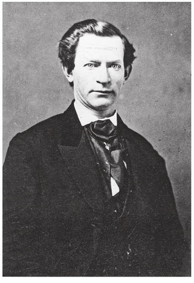
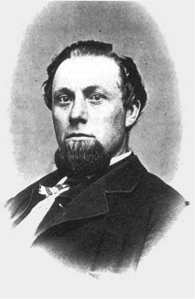
Lifeline
Recommended Links
- Ancestry.com (census records, city directories, and more; paid account required – Visit
- Center for Colorado Women’s History – Visit
- Pikes Peak Library Digital Collections – Visit
- Family Search website has U.S. Federal Census and more; free account required – Visit
- Geneologybank.com has a selection of digitized newspapers from the United States; paid account required – Visit
- Newspapers.com has a selection of digitized newspapers from the United States; paid account required – Visit
- Newspaperarchives.com has a selection of digitized newspapers from the United States; paid account required – Visit
Transcript
You’re listening to Photographs, Pistols, and Parasols.
Support for this project is provided by listeners like you. Visit my website at p3photographers “dot” net for ideas on how you, too, can become a supporter of the project.
Welcome to Photographs, Pistols & Parasols, the podcast where we celebrate early women artisan photographers.
I’m your host, Lee McIntyre.
I’m excited today to bring you the start of Season 3 here on Photographs, Pistols & Parasols.
This season, it’s all about connections.
For more information about any of the women discussed in today’s episode, visit my website at p3photographers.net.
That’s letter “p”, number “3”, photographers “dot” net.
*****
Today we’re going to explore connections.
Specifically, the kinds of connections that we might find between photographers working in the same town or in different towns at the same time or in different time periods but connected by other things, people, or events …
Now, I’ve been talking about connections between photographers for a while.
I profiled all of those women in Blue Rapids [Kansas], and also all the women in Lowell, Massachusetts.
Those women were connected by place, but also some of them by time periods, because they were contemporaries working together in the same town.
But it’s not just connections to other photographers that I want to talk about.
Because, as I’ve been doing this podcast research, I’ve been stumbling across interesting bits of information that connects the photographers that I’m talking about to other kinds of people, places, and famous events, things that were unexpected to run across, particularly since they had a connection to one of our early women photographers.
Along the way, I’ll continue to explore the same kinds of multi-threaded narratives that we’ve been talking about all along.
But as I mentioned at the end of Season 2 last time, I really want to figure out how I can bring you more of these women and more of their stories.
Here in season three, we’re going to do that by looking at connections between different photographers.
To start things off I want to go back to Episode 22, when I talked about a woman named Belle Bybee Chase.
I’m going refer you back to Episode 22 for a lot of the details about Belle Bybee Chase, but I want to focus in [today] on one aspect of her career: the point at which she was living and working in Denver, Colorado.
It’s the late 1890s, and she’s just gotten divorced from D.B. Chase.
D.B. Chase, who had also been a photographer, had moved away from Denver and Belle B. Chase got the business after he left.
She builds that into a very successful high society kind of business there in Denver in the late 1890s.
And so, circa 1900, it probably comes as no surprise that she’s the one that a high society mother picks to actually take a picture of her high society daughter.
The daughter’s name was Cornelia Baxter.
She was a very popular debutante there in Denver in the late 1890s.
She’s been engaged to a young man named Gerald Hughes.
He’s very prominent, the son of a Colorado senator, and a very good match for our wealthy debutante, Cornelia Baxter.
But in 1901, Cornelia and her parents embark on a trip to San Francisco, leaving Cornelia’s fiance, Gerald, behind.
Cornelia meets a very wealthy businessman in San Francisco, a man named Hugh Tevis.
Now, Hugh Tevis actually had been married before, and he had a young daughter.
But he and Cornelia fall in love, and when Cornelia gets back to Denver, she announces that she is jilting Gerald Hughes in favor of a marriage with Hugh Tevis.
Now, Gerald Hughes is not that happy.
He famously vows, “I will be revenged”, because he is very upset about Cornelia dumping him.
While [Cornelia and Hugh] are waiting for the marriage to take place, and all the wedding stuff to be sorted out, Cornelia is back in Denver and Hugh Tevis, her new intended, is still in San Francisco.
So Cornelia’smother goes to B.B. Chase and asks Mrs Chase to take a picture of her daughter, the idea being that that picture will be sent to Hugh Tevis so that he will not forget his beautiful intended before the wedding date.
The picture is taken and put in a frame.
But before it can be sent to San Francisco, somebody actually breaks into B.B. Chase’s studio and steals the photo — as it says in the paper — “right out of the frame”.
Suspicion falls, of course, on Gerald Hughes — after all, he did vow revenge.
But ultimately that is not enough to break up Hugh and Cornelia, and they’re actually married in 1901.
They immediately set sail for a honeymoon trip to Asia.
Sadly, just a few months after their marriage, and while they’re still on their honeymoon there in Japan, Hugh Tevis takes ill and dies.
Cornelia is left with her young stepdaughter and also, as it turns out, she’s already pregnant with the son will become Hugh, Jr.
Cornelia Baxter Tevis goes on to have a really colorful life, and this story about that picture being stolen is dredged up every single time she is in the news.
She is [often] in the news because of her subsequent marriages, and subsequent really, really messy divorces.
Ultimately, Cornelia Baxter becomes Cornelia Baxter Tavis McKee Toumlan Gower.
Again, Cornelia was not a photographer, and her story is only tangentially related to the early women photographers.
But that’s kind of what I call an “unexpected development”: when I’m looking for these women photographers.
It’s a bit of interesting information that is related to the photographer, but not really involving a direct participation of the photographer in the ultimate events.
I mean, obviously Mrs B.B. Chase took that photo, but the ultimate events really didn’t have anything to do with Mrs B.B. Chase.
So that’s the “unexpected development” kind of connection that we have with some of our early women photographers.
But if we go back to Colorado in the1890s, we find a different kind of connection when we look at the next woman photographer, a woman named Julia Skolas.
Now, Julia Skolas was a contemporary of B.B. Chase only in the sense of working at the same time period in Colorado.
She was active in Colorado Springs in the late 1890s, just like B.B. Chase was active in Denver in the late 1890s.
Julia Skolas had a really long career, first in Colorado Springs for more or less 10 years.
Then she moved to the mining town of Cripple Creek, Colorado, where she was active for about 17 years, taking pictures in a studio — doing artisan photography, you know, the portraits of the men and the women and the kids — but also taking pictures in the mines.
And she’s really famous for pictures she actually took inside mines.
Now, again, this is in the early 1900s, and the technology that existed then to get those kind of pictures — it wasn’t like there was a simple flash, more like flash powder, which if you think about the fact that you’re doing flash powder shots inside of mine, [that’s a] little bit dangerous.
But Julia Skolas knew what she was doing.
She’s also noted for these wonderful landscape views, which she sold as postcards.
And these landscape views are spectacular vistas that she also hand painted, sort of colorizing things, again in the early 1900s.
After her long tenure in Cripple Creek, Colorado, she ultimately moves to Denver, Colorado, where she operates doing photography for another (not-quite) 10 years, until she moved back to her native Wisconsin toward the end of her life.
And that’s actually where she dies.
Now, the Pikes Peak Library District Digital Collections has a lot of online scanned images by Julie Skolas.
I’ll put a link in the episode notes to those.
It was wonderful to see this very vibrant woman doing lots and lots of photography for decades, running a very successful photography business in several different locations there in Colorado.
One thing that always sort of amuses me, though, when I run across it, is that there is a description of her one of the online sites — which [otherwise] has great information about her — but the comment is made that she’s only one of a “handful” of successful pioneer women photographers whose work is still available to see.
Hopefully, if you’ve been listening to Photographs, Pistols & Parasols, you’ll agree with me that it’s not quite the case that she’s really only one of a few women whose work still survives; the problem is figuring out where it is and how to see it.
But hopefully you get the idea that Julia Skolas adds to this body of early women photographers work that I’ve been talking about here on the podcast.
Now in doing research on Skolas, I ran across a notice for a woman named Julia Bottomley.
Julia Bottomley was active as a photographer in 1894, working with her husband, T.F. Bottomley.
Julia and her husband, T.F., were actually active in Kentucky before they ever moved to Colorado.
But then in the early 1890s, there’s a notice in the papers that [says] that T.F. Bottomley studio burned down.
Maybe that gave them the impetus to actually move to Colorado?
They do show up in Colorado in 1892, taking over a studio in Pueblo, Colorado.
Now, Pueblo, Colorado actually has another connection to B.B. Chase, at least of a sort.
B.B.’s husband, D.B. chase, the one who had been the photographer with her in Denver, well he had been a photographer actually in Pueblo, Colorado, many years before, in the 1870s.
I don’t think it’s possible that there was any crossover between the Chases and the Bottomleys in Pueblo, Colorado, but it was intriguing to see that they were in the same spot, at least even if it was about fifteen years apart.
Anyway, Julie Bottomley is actively doing photography by in the early 1890s.
Her husband is running the studio, while she’s going around doing photography in different places.
There’s actually a notice in [the newspapers] that she’s in Atchison, Kansas, at one point doing photography.
Then she goes to Tennessee to do some photography, some sort of course or something — it’s not really clear what’s going on.
But then, the intriguing thing about the Bottomleys is that there’s a confusing set of notices circa 1896 that talks about a divorce.
Sort of.
In January of 1896 there’s a notice that the divorce suit has been dismissed.
But then in March of 1896, two months later, Julia is actually been granted the divorce and custody of their children.
But then it seems like they’re still living together [after that].
But maybe it’s around that time that the marriage is not going well that Julia takes up another profession.
Now, she’s still doing photography, but simultaneous with that she starts to do fashion writing, [i.e.] writing about fashions of the day.
By the early 1900s Julie Bottomley has left photography behind, pursuing instead — full-time — that career doing fashion writing.
What I’m looking at on my computer right now is a picture of Julia Bottomley from her 1924 passport application.
She’s got a very serious expression on her face … she looks very prim and proper … her hair is pulled back … she’s got spectacles on … and a nice lace collar.
In that same passport application, it’s mentioned that her husband died in 1902.
The curious thing about that, though, is that T.F. Bottomley, her husband, actually advertises in a Kentucky paper looking for photography work as late as 1908.
Now on ancestry.com I did find someone who had pieced together information about a T.F. Bottomley that I think is Julia Bottomley’s husband, and he actually doesn’t die until 1910.
So it would seem that Julia Bottomley calls herself a widow rather prematurely, starting in 1902, and that may indicate that maybe they did ultimately get a divorce.
I certainly have seen other divorced women describe themselves as “widows” after a divorce.
But Julia Bottomley, while she gives up photography, she is incredibly successful as a fashion writer.
She is a syndicated columnist, syndicated all over the United States.
And [she] also travels to Europe, which is what she’s doing in 1924, reporting on fashion.
It was really fun was to find that one of her big articles circa 1915 was actually on one of the “new trends” and “novel shapes” in something of a day, the very fashionable: a parasol.
Because my podcast is Photographs, Pistols & Parasols, that was particularly fun to find.
Julia Bottomley, even though she gives up the photography, she still has connections to things that are related to this podcast like the parasols. 🙂
And that’s another kind of connection, in that Julie Bottomley was a photographer, but seemingly not for terribly long, just several years.
But then she goes off in another direction and has a very interesting career that doesn’t really have much to do with photography, but still very worthy of note.
[Now], looking around for information about the Bottomleys, I ran across information about another woman who had opened her studio in another small town called Black Hawk, Colorado in 1871, 20 years before.
And that woman’s name was Mrs R.A. Clark.
This Mrs. R.A. Clark was a Mrs Robert A. Clark; her given name was Lucinda.
So in 1871 there’s a notice in the newspaper announcing the opening of “new photographic rooms run by Mrs R.A. Clark”.
Unlike Mrs Bottomley, Mrs R.A. Clark had not been married to a photographer.
When she opens up her studio, she does it solely as a means of support for herself and her young daughter.
She had been left a widow just a couple of years earlier, and without any means of support, she has happened on photography has the way she’s going to be able to make money.
In trying to research Lucinda Clark, I ran across some interesting information that, again, had very little to do with photography, but it was another set of connections to interesting events and other interesting noteworthy people.
Let’s start with Robert A. Clark, Mrs R.A. Clark’s husband.
It turned out that he’d been a Marshall there in Colorado.
He was killed in the line of duty in 1869.
When Mrs Clark is widowed, the city actually takes up a collection, essentially, to give her a small pension to help her and her daughter initially, right after her husband dies .
But Robert A. Clark is actually very famous because he was the first Marshall killed in action in Colorado.
There’s a monument to him in Colorado.
Learning about him just opened up this whole avenue of exploration for something that I never looked into, which was the history of law enforcement in Colorado.
So that was the first interesting connection and side story for Mrs R.A. Clark.
But in looking at some records I realized that the little girl who was the daughter, who was left when when Robert A Clark died, was actually named Sophia Dougherty, and not Sophia Clark.
I.e., Lucinda Clark’s little girl was not Robert A. Clark’s daughter.
So, who was she?
Digging a bit deeper, it turned out that Lucinda Clark was actually born Lucinda Converse.
And Lucinda Converse was married to a man named Michael Dougherty circa 1860.
And Michael Dougherty is actually famous in Denver for being Denver’s first comedian – that’s what’s on his headstone.
He famously founded this theater troupe in Denver and is written up in books and his wife is mentioned in passing, and it’s mentioned in passing when he dies that as he left a widow with a small child.
So the daughter that [Lucinda} has with Michael Dougherty is the daughter that is left after her second husband, Robert A. Clark, is killed.
So that was another interesting side story: the history of Denver’s theater up district and the theatre companies that first played in Colorado.
Fascinating – and Michael Dougherty was a fascinating character all in his own right.
But again, just an interesting side story connected to our photographer, Mrs R.A. Clark.
Now Mrs. R.A. Clark runs that photography studio there in Black Hawk, Colorado for just a couple of years.
Unfortunately, in 1873 there’s a huge fire in town, and Mrs. Clark’s studio is one of the many businesses destroyed.
There’s no evidence that she ever tried to reopen her gallery, while she does collect some insurance money on it.
But perhaps that gives her enough money to live on for a while.
It’s not entirely clear what she does over the next few years.
The next major event in her life is, sadly, another tragedy when, in 1879 her daughter, Sophia, dies at the age of only 16.
But then, in 1884, we find a happy event in Lucinda’s life.
That’s the year Lucinda moves on and gets married again to a man name Richard W. Mosley.
It doesn’t appear that she ever did photography again after she left Black Hawk, Colorado.
So that might have been where the story ended.
But what was intriguing was running across a third connection for Mrs Robert A Clark.
Because it turns out that one of the things she did after her marriage to her last husband, Richard Moseley, was she founded something called the Social Order of the Beauceant.
Let me read you the description from their brochure:
The Social Order of the Beauceant is an organization of Christian women whose membership is limited to the wives and widows of the Knights Templar. It was founded in Denver, Colorado in February of 1890.
Now, I’d never heard of the woman’s order of the Knights Templar [before].
It turns out there Richard Mosley, her last husband, was a very prominent Knight Templar, and she and some other women thought it would be great to have a women’s organization affiliated with that group.
It was founded by Lucinda Converse Dougherty Clark Mosley, the woman who had been a photographer for a couple of years after her Marshall husband was killed in action, there in the 1870s.
*****
So those are some examples of the various kinds of connections that I run across what I’m doing these kinds of explorations of the early women photographers.
And in the episodes this season, for the next eight episodes, I’m going to be exploring some more connections like this.
So in the next episode we’re going to take up a connection with Mrs R.A. Clark by looking at one of her contemporaries to when she opened that studio there in [Black Hawk} Colorado.
Well, at the same time there was a woman running an artisan studio in Lawrence, Kansas.
That connection — in terms of these two women running studios at the same time but in different locations — will actually lead us back to Kansas.
We’re going to be on the trail of a rather mysterious woman … which will also then lead to a very unusual story about a famous event … and also the launch of a photographic dynasty.
All of those stories are coming up in the next episode.
I hope you’ll join me!
*********
Before I end today, I do want to thank several people.
First, Bill Thomas and the research staff at the Pikes Peak Library District Special Collections Room, for pointing me toward information about Julia Skolas, as well as some other women who will pop up eventually here on Photographs, Pistols & Parasols.
Anyway, I really want to thank them for their help when I stopped by last year to do research using materials in their microfilm colleciton.
I also want to give a special shout out to “Marley and Friends” [from the staff] for the wonderful review they left for the podcast on iTunes.
In the episode notes I’ll include links to the information about Julia Skolas, including photos by her that are in the Pikes Peak Library District Digital Collecitons website
I also want to thank Jillian Allison, Mike Erickson and the staff at the Center for Colorado Women’s History for inviting me to stop by to give a special talk to staff back in April.
They all actually got a sneak preview of the some of the material that I’ve included in in today’s episode.
The Center for Colorado Women’s History is new, and it’s a wonderful museum in a historic mansion, full of interesting items, including some old family photographs that we looked through, looking for examples by women photographers.
That reminds me – I do give presentations and workshops about these early women photographers.
I tailor the material to include women and subjects to match the interests and areas of the groups that invite me.
If you’re interested in having me stop by to give a talk, just contact me at podcast “at” p3photographers.net.
Now, as always, materials I’ve talked about today will be availalbe my website, in the notes for today’s episode, at p3photographers.net.
That’s letter “p”, number “3”, photographers “dot” net.
I’ll include photos taken by Julia Skolas, writings by Julia Bottomley, and photos of Lucina Converse Doughterty Clark Mosley and two of her three husbands.
Plus, I’ll include a photo of Cornelia Baxter and 2 of her children from the period when she was Cornelia Baxter Tevis Mckee.
Unfortunately, I don’t have the photo that was taken by Mrs. Chase and then stolen from her studio.
But it’s still going to fun to get a glimpse of Cornelia herself. .
Other work by Mrs. Chase, of course, can be found in the notes for Episode 22.
Also, I want to give a special thanks to the listeners who alerted me this week to some photos by Mrs. B.B. Chase that are currently listed on ebay.
They are artistically styled photos of young women posing al la Venus.
For some young, daringly modern, weathly women, posing for their portraits [while] artisticaly drapped in gauzy cloth, garlands of flowers, and little else was all the rage.
And it turns out that Mrs. B.B. Chase was a talented portrait artist for studio portraits of all types.
You’ll need to search for those photos on ebay yourself, since any link I would put now will be out of date once they are sold.
But in any case, I really want to thank the listeners who alerted me to the items currently by Mrs. Chase on ebay.
If you run across anything related to early women photogers, or if in general you have any questions or comments in general, just drop me a line at podcast “at” p3photograhers.net.
Or, follow me on facebook, at facebook.com/p3photographers, and then contact me that way.
This podcast relies on the support of listeners like you.
One free way to help more people find the podcast is to leave a 5 star rating on Apple Podcast (formerly known as iTunes).
For other ideas on how you, too, can become a supporter of the project, go to my website at p3photographers.net.
That’s it for today.
As always, thanks for stoppping by.
Until next time, I’m Lee, and this is Photographs, Pistols & Parasols.
